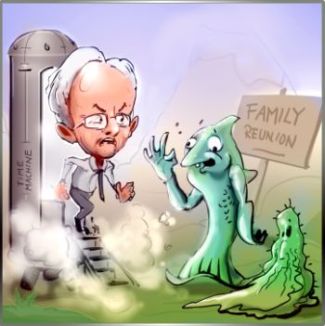Steve Jones and Hans Christian Andersen

What do Steve Jones and Hans Christian Andersen have in common? They both tell great fairy tales.
Evolutionary geneticist Steve told a beauty in his latest article “Islam, Charles Darwin and the denial of science” published in The Telegraph on 3 December 2011.1 Here is how he starts:
“The story began long ago, when our ancestors were fish. … ”
Our ancestors were fish?! You must agree that is an imaginative story! But Steve is serious and he gets upset because some of his students at University College London don’t believe him.
“Some [Muslim students], unfortunately, refuse to accept Darwin’s theory on faith grounds, as do some of their Christian fellows.”
But why should anyone accept Darwin’s theory on faith grounds? (Sorry, I couldn't resist that pun.) Steve should provide evidence. What evidence does he give that molecules once turned into a living, self-replicating cell—presto? (It had to be “presto” because all the interdependent, nano-machinery had to appear suddenly at the same instant or it would not work.) Further, what evidence does he give that this single cell evolved over billions of years into people?
Evidence is what makes science different from fairy tales. To be fair, Steve says he did appeal to his students with evidence:
“I have tried asking students at quite what point they find my lectures unacceptable: is it the laws of inheritance, mutation, the genes that protect against malaria or cancer, the global shifts in human skin colour, Neanderthal DNA, or the inherited differences between apes and men?”

There is no argument over this evidence. What we don’t accept is Steve’s belief that this evidence supports molecules-to-man evolution. It doesn’t.
- the laws of inheritance These work on information already present in the genome. They do not create any new genetic information. (Inheritance of biological information—part I: the nature of inheritance and of information)
- mutation These are copying mistakes and spoil the genetic information. In some environments these can have beneficial outcomes but they still degrade the genetic information. Mutations have been observed to take feathers off a bird but not put feathers on a lizard. (Mutations Questions and Answers)
- the genes that protect against malaria or cancer These are just specific examples of the previous two points of inheritance and mutation—no new genetic information. (Misotheist’s misology: Richard Dawkins attacks Michael Behe, Clarity and confusion (A review of The Edge of Evolution by Michael J. Behe))
- the global shifts in human skin colour Just another example of inheritance and mutation that likewise goes the wrong way for bacterium-to-biologist evolution. Actually, accumulating genetic information for humans supports biblical history, not evolutionary scenarios. (Where did the human races come from?)
- Neanderthal DNA So? Neanderthals were human. They were early post-Flood migrants from Babel into Europe. (What do fossil and genetic evidence suggest about Neandertals?)
- the inherited differences between apes and men Inherited? Who observed that? Apes and humans are distinct creations. The similarities are due to common design, and are evidence that there is one Designer. (What about the similarities between ape and human DNA? Does this support evolution?)
A search on creation.com on relevant key words (e.g.: ‘inheritance’, ‘mutation’, ‘natural selection’, ‘malaria resistance’, ‘human skin colour’, ‘human genome’, ‘Neanderthal DNA’, ‘ape human similarities’) reveals lots of articles that address the evidence and present the arguments why it does not support evolution.
This is why the students think Steve’s interpretation of the evidence is not compelling. So, instead of calling them names and saying that they deny science, scientists like Steve Jones should respect their skepticism and engage the scientific arguments.
References
- Jones, S., Islam, Charles Darwin and the denial of science, The Telegraph, 3 December 2011; www.telegraph.co.uk/science/8931518/Islam-Charles-Darwin-and-the-denial-of-science.html. Return to text.



Readers’ comments
Comments are automatically closed 14 days after publication.